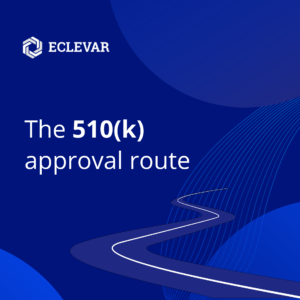If you wish to place a medical device on the US market, and a Premarket Approval Application(PMA) is not required, then you will be required to have 510(k) clearance.
*A new 510(k) submission is also required for changes and modifications to a device already on the market, where the changes could have a significant impact on the safety or effectiveness of the device.
The underlying principle of this process is that your product can be demonstrated to be safe and effective, based on a demonstration of ‘substantial equivalence’ to a device(s) already marketed in the US.
THERE ARE THREE 510(K) PATHWAYS:
|
Pathway |
Key points |
|
|
Traditional |
Can be used under any circumstance when seeking access through the 510(k) programme |
|
|
Special |
More efficient route for products that have already been through the traditional route, but have changes that require the product to go through clearance again. |
Full guidance: The Special 510(k) Program | FDA |
|
Abbreviated |
uses guidance documents, special controls, and/or voluntary consensus standards to facilitate FDA’s premarket review of 510(k) submissions. All aspects of the 510(k) submission must be covered, but applicants can chose to submit summary reports on the use of guidance, demonstrate compliance with any special controls in place and declaration that recognized standards have been conformed to. |
Full guidance: The Abbreviated 510(k) Program | FDA |
SUBSTANTIAL EQUIVALENCE
Central to the 510(k) pathway is the principle of substantial equivalence to a ‘predicate’ device
What counts as a predicate device?
- A legally marketed device that was marketed prior to May 28th 1976
- A device that had been reclassified from Class III to class II or I
- A device that was found to be substantially equivalent through a 510(k) submission
- A device granted marketing authorisation through the De Novo classification process
If there is no appropriate predicate device, then manufacturers will need to submit a De Novo request or for high risk products a Premarket Approval may be required.
Demonstrating substantial equivalence:
The device under review has:
- the same intended use as the predicate; AND
- the same technological characteristics as the predicate; OR
- the same intended use as the predicate; AND
- has different technological characteristics and does not raise different questions around the safety and effectiveness; AND
- the information submitted to FDA demonstrates the device is as safe and effective as the predicate device.
Aspects that should to be considered in the comparison:
- intended use
- indications for use
- target population
- anatomical site
- where used (hospital, home, ambulance, etc)
- energy used and/or delivered
- human factors
- design
- performance
- standards met
- materials
- biocompatibility
- compatibility with the environment and other devices
- sterility
- electrical safety
- mechanical safety
- chemical safety
- thermal safety
- radiation safety
SUBMISSION REQUIREMENTS
- Identify a predicate device – this is usually through a search of the FDA 510(k) Database. Useful information to support the search:
- names of similar devices – traded name under which the device is marketed;
- manufacturer(s) of the similar device(s);
- marketing status, i.e., pre-amendments or post-amendments device;
- 510(k) numbers for post-amendments devices;
- classification information, i.e., product codes, classifying regulations, etc., for your device.
- Identify relevant guidance – The FDA guidance library should be reviewed. Any relevant device-specific guidance should be considered early on. The guidance may provide detailed information that should be included in the 510(k) submission, this will support and aid the review of the submission.
- Documentation & content – there is no ‘form’, you need to present the information in an organized document. The document should contain the following:
- General information: this includes manufacturer details, device name, classification, justification for the 510(k), the predicate identified and compliance with any special controls.
- Table of contents
- 510(k) Acceptance checklist
- Statement of indications for use: this should include specific indications, clinical settings, target population, anatomical sites etc.
- Proposed labelling: this also includes instructions for use, service manuals, and advertising material.
- Specifications: narrative description of the device and a physical/technical description.
- Substantial Equivalence comparison table
- Performance data: the extent of this will depend on the complexity of the device and its indications for use.
This is not an exhaustive list and further guidance can be reviewed on the FDA website: https://www.fda.gov/medical-devices/premarket-notification-510k/content-510k#link_3
TIMELINES AND COST
You cannot market your device until the FDA have deemed it to be substantially equivalent – this decision is usually made within 90 days and is solely based on the information you provide in your submission.
Applicants will received one of two findings: SE (substantially equivalent) or NSE (not substantially equivalent).
510(k) submission cleared by the FDA are published – usually in the first week of the following month.
FDA User fess 2023 for the 510(k)
Standard user fees: $19,870
Small Business Fee: $4, 967
As of October this year, applicants for the 510(k) route can send an electronic submission through the CDRH Customer Collaboration Portal. From the 1st October 2023, all application will need to be submitted in this manner.

